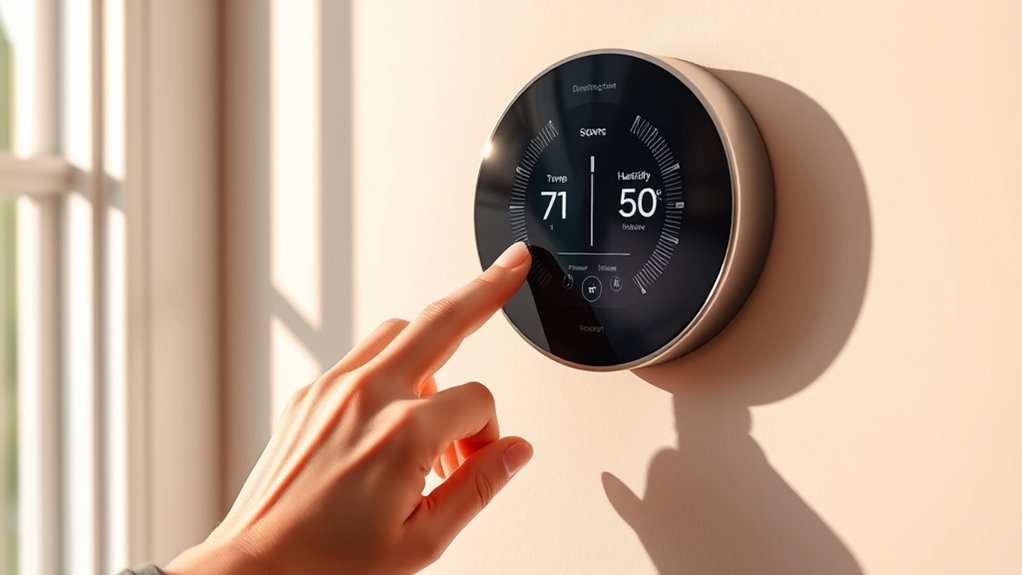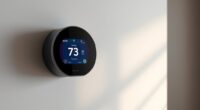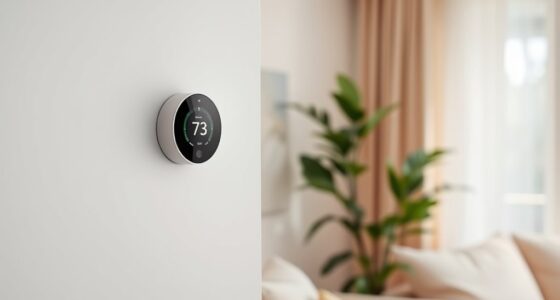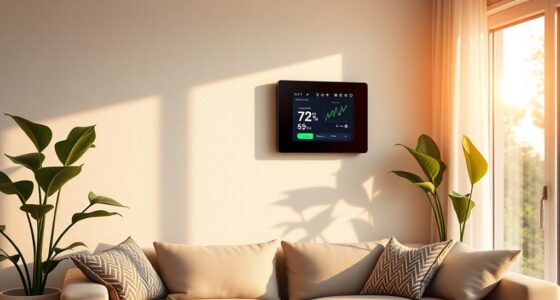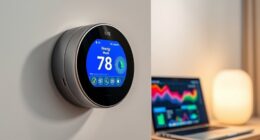To reduce seasonal allergies, set your smart thermostat to maintain ideal humidity levels between 40-50%, preventing mold and dust mites. Integrate air quality sensors to monitor pollen and airborne particles in real-time. Automate your system to increase ventilation or activate air purifiers when allergen levels rise. By adjusting based on sensor data, you can create a healthier indoor environment. Stay tuned to discover more ways smart thermostats can help you breathe easier during allergy season.
Key Takeaways
- Use smart thermostats to automatically adjust humidity levels between 40-50% to prevent mold and dust mites during allergy season.
- Integrate air quality sensors with your thermostat to detect pollen, mold spores, and airborne particles in real-time.
- Set automated ventilation or air purifier activation when allergen levels exceed safe thresholds.
- Schedule temperature and humidity changes to reduce seasonal allergens without manual intervention.
- Leverage remote control features to monitor and modify indoor air conditions from anywhere during allergy-prone periods.
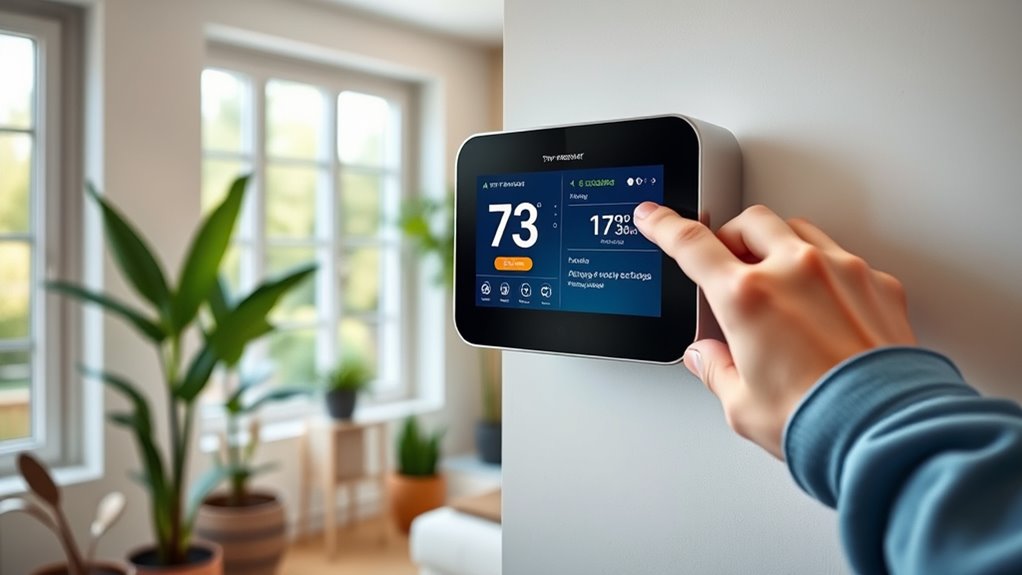
Smart thermostats have revolutionized the way you control your home’s climate, making it easier to save energy and stay comfortable. When dealing with seasonal allergies, these devices become even more valuable. They can help you manage indoor air quality and humidity levels, which are essential for allergy sufferers. Many smart thermostats come equipped with air quality sensors, allowing you to monitor pollutants, allergens, and other airborne particles directly from your smartphone or control panel. By detecting elevated levels of dust, pollen, or mold spores inside your home, these sensors enable you to take quick action, like increasing ventilation or running an air purifier, to reduce allergen buildup. This proactive approach helps create a healthier environment and minimizes allergy symptoms. Additionally, some models can integrate with air filtration systems, providing an extra layer of allergen control and ensuring cleaner indoor air. The integration of automation technology allows you to set schedules that optimize air quality without manual adjustments. Humidity control is another vital feature of smart thermostats that benefits allergy sufferers. High humidity levels can promote mold growth and dust mite proliferation, both of which worsen allergy symptoms. Conversely, overly dry air can irritate your respiratory system. A smart thermostat with humidity control allows you to set ideal levels—usually between 40% and 50%—and automatically adjusts your HVAC system to maintain that range. During pollen season, keeping humidity in check prevents mold growth, which can be a significant allergen. It also helps keep dust mites at bay, reducing triggers that can cause sneezing, congestion, and itchy eyes. With these features, you’re not just maintaining a comfortable temperature but also creating an environment that’s less hospitable to common allergens.
Frequently Asked Questions
Can a Smart Thermostat Detect Pollen Levels in the Air?
Your smart thermostat can’t directly detect pollen levels in the air, but it uses air quality sensors and pollen detection technology to monitor overall air quality. These sensors identify pollutants and allergens, providing you with data that can help you adjust your home’s ventilation or filter settings. While it doesn’t specifically measure pollen, integrating smart air purifiers or sensors can improve indoor air quality during allergy season.
How Do Smart Thermostats Improve Allergy Symptoms During Seasonal Changes?
Smart thermostats improve your allergy symptoms during seasonal changes by optimizing air purification and humidity control. They automatically adjust settings to reduce pollen and mold spores indoors, creating a cleaner environment. By maintaining ideal humidity levels, they prevent mold growth and dust mites. These features work together to make your home less hospitable to allergens, helping you breathe easier and feel more comfortable during allergy season.
Are There Specific Settings for Mold Prevention With Smart Thermostats?
Think of your smart thermostat as a guardian for your home’s air quality. For mold prevention, you should set it to prioritize air quality settings that reduce humidity, making your space less inviting for mold. Keep the temperature steady and humidity below 50%. Regularly monitor your indoor air quality, and use the smart thermostat’s features to adjust airflow and humidity, creating a hostile environment for mold and safeguarding your health.
Can Smart Thermostats Automatically Adjust Based on Allergy Forecasts?
You can set your smart thermostat to automatically adjust based on allergy forecasts. It creates an automatic schedule that reacts to real-time allergy data, reducing indoor allergens like pollen and mold. When the forecast predicts high pollen levels or mold spores, the thermostat lowers humidity or adjusts temperature settings to prevent mold growth and minimize allergens. This proactive approach helps you breathe easier without manual intervention, enhancing your allergy management.
How Effective Are Smart Thermostats Compared to Traditional HVAC Adjustments for Allergies?
You’ll find that smart thermostats can be quite effective compared to traditional HVAC adjustments for allergies. They optimize climate control by integrating with air filtration systems and scheduling HVAC maintenance, reducing pollen and dust indoors. Unlike manual tweaks, smart thermostats automatically adjust settings based on real-time data, helping you maintain a healthier environment. This technology offers more precise control, making it easier to manage allergy symptoms effectively and consistently.
Conclusion
By adjusting your smart thermostat for seasonal allergies, you can create a more comfortable and healthier home environment. Remember to keep your humidity levels in check and set your system to filter out pollen effectively. Isn’t it worth taking a few simple steps to breathe easier and enjoy the changing seasons? With just a few quick adjustments, you’ll be surprised at how much smoother allergy season can feel. Why not give it a try and see the difference yourself?
